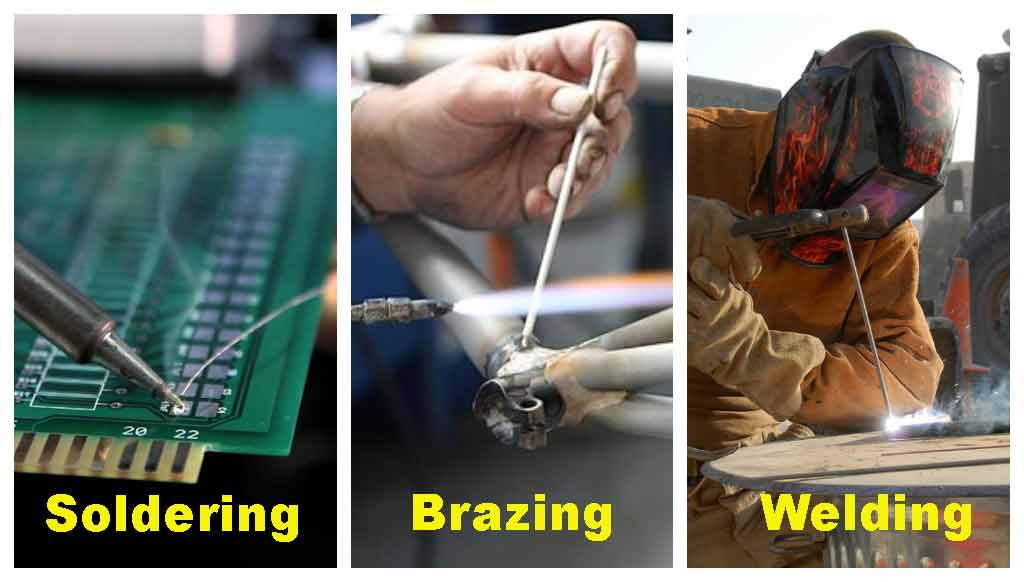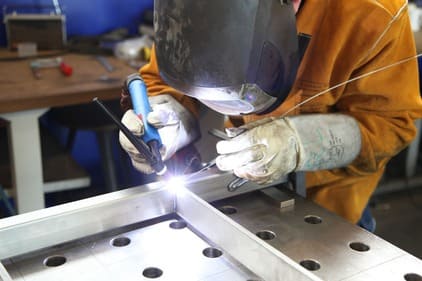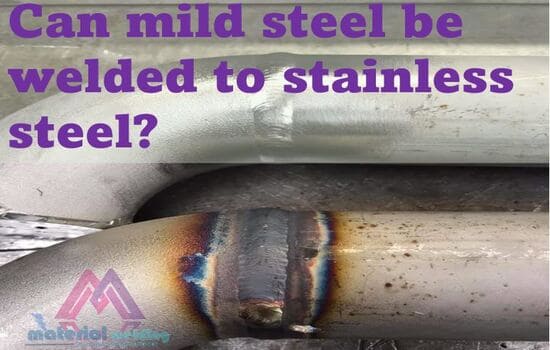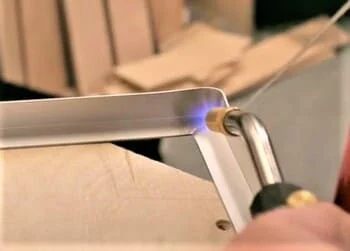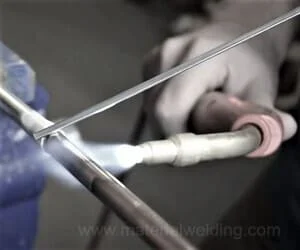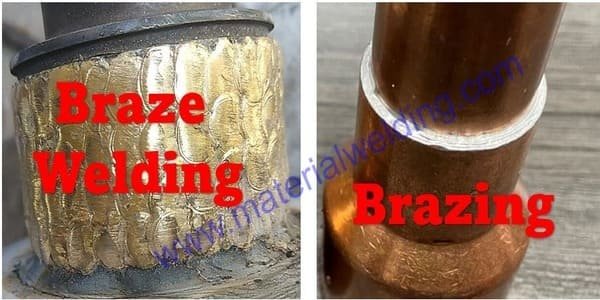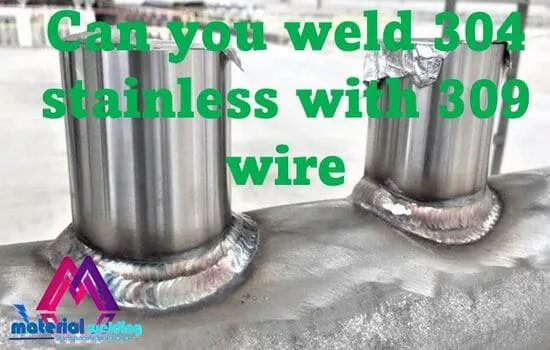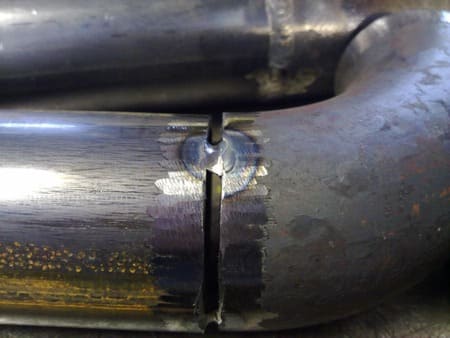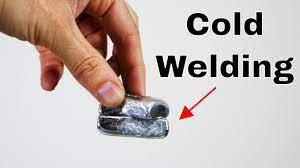Dissimilar Metals Welding
Dissimilar metal welding or joining by brazing or by solid-state welding processes (such as friction welding, diffusion bonding, and explosive welding) is feasible in most combinations. When fusion welding processes are used, success depends on several factors.
What are Dissimilar Metals?
Dissimilar metals mean either:
- Those that are chemically different (example: steel, copper, aluminum) or
- Those that are metallurgically different (example: mild steel, stainless steel).
Weldability issues with Dissimilar Metals Welding
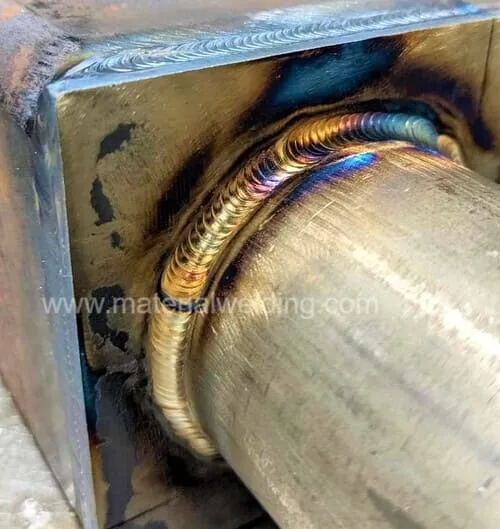
If the melting points of the two members being welded differ by more than 100°C, solidification and shrinkage of the metal with the higher melting point will induce stresses in the other metal, which is only partially solidified and therefore weak, and cause it to rupture.
In some cases, the problem is solved by buttering the joint surface of the higher melting base metal with a filler metal, whose melting point lies between those of the two base metals.
The final weld is made between the buttered face and the other base metal. The filler metal should be one which is suitable for the lower-melting base metal.
If a high-melting filler metal is used, there will be excessive dilution from the low melting base metal. Mild steel and aluminum are examples of two metals having widely different melting points.
Dissimilar Metals Welding Thermal conductivity concerns
When two metals of significantly different thermal conductivities are being welded, the heat input can be right for one and either too less or too much for the other.
This is because of the differing rates of heat conduction from the molten pool to the two base metals. Proper heat balance is achieved in this case by directing the arc at the higher thermal-conductivity base metal or by selectively preheating it.
Compared to mild steel, copper and aluminum have very high thermal conductivity, while austenitic steel and Monel have much less.
Dissimilar Metals Welding Thermal expansion concerns
If the two metals being welded have different coefficients of thermal expansion, the resultant joint has high internal stresses.

This factor becomes more serious when the joint is exposed to cyclic temperatures in service. A common example is the joining of 244 Cr-1 Mo steel to type 304 or 316 austenitic stainless steel in thermal power plant.
The coefficient of thermal expansion of the former is about 25% less than that of the latter.
In this case, it is, advisable to choose a filler metal whose thermal expansion coefficient is intermediate between the two.
The filler metal must also have sufficient ductility to tolerate the high stresses. An Inconel filler metal satisfies these conditions.
Dissimilar Metals Welding weld dilution concerns
An important factor is dilution of the filler metal by the two different base metals. In fusion welding, the filler metal and some portions of the base metal melt together and form the weld pool.
Hence the filler metal must be capable of alloying readily with the base metals and produce a weld-metal that is ductile and crack-free.
If complex phases or intermetallic compounds are formed in the resultant weld-metal, the joint will have poor mechanical properties and will be unsuitable for service.
Dissimilar Metals Welding weld microstructures concerns
Metallurgically, the weld-metal in dissimilar joints will be either a single-phase or a mixture of two or more phases.
A phase can be an intermetallic compound (example: Cu-Al compound), an interstitial compound (example: iron carbide or titanium carbide), or a solid solution (example: copper and nickel).
An intermetallic compound is to be avoided. The role of an interstitial compound is variable. Solid solutions are desirable because they help to produce a good weld. Copper and nickel are readily weldable to each other because they form a series of solid solutions when melted together.
The soundness and mechanical properties of a dissimilar weld joint are determined by the number, type, relative proportion and metallurgical arrangement of the phases present in the weld-metal.
Weldability of a dissimilar metal combination can often be predicted by examining the phase diagram of the metals concerned.
If intermetallic compounds are formed, one must use solid-state welding processes instead of conventional fusion welding processes. The following chart indicates the degrees of weldability of various metal combinations.
Dissimilar Metals Welding Preheat & Interpass Temperature
For dissimilar metal joints, preheat and postweld heat treatment procedures have to be selected with care. When only one of the two metals needs to be preheated, one must make sure that the preheat can be applied independently to the proper side of the joint.
The postweld heat treatment can be problematic when the heat applied to one metal is harmful to the other. A typical example is the welding of an age-hardenable Ni-Cr alloy to unsterilized austenitic stainless steel.
When aging treatment is given to the Ni-Cr alloy, it will make the latter sensitive to intergranular corrosion. The problem can be overcome by using a stabilized stainless steel.
Alternatively, the joint face of the age-hardenable Ni-Cr alloy component can be buttered with a non-age-hardenable Ni-Cr alloy and it can be age-hardened independently. The buttered surface can then be welded to the stainless steel component.
The problem of metallurgical incompatibility can sometimes be solved by the use of a filler metal shim or welding each of the metals to a compatible transition piece.
For example, 321 SS filler shims are used in between Hastelloy X and SAE 8620 steel; Hastelloy B shims can be used for welding of 304 SS to Monel as well as for A-286 SS to SAE 4140 steel.
Welding of Dissimilar Steels
In thermal power stations, oil refineries, etc., various combinations of carbon steel, low-alloy steels and stainless steels have to be welded, mainly in the form of pipes. In Table below these steels are listed along with their abbreviations used for convenience.
Base metals for piping Type of steel
| Base metals for piping Type of steel | Short form |
| Carbon Carbon-½ Moly ½ Chrome – ½ Moly 1 Chrome – ½ Moly 1.25 Chrome – ½Moly 2 Chrome – ½ Moly 2.25 Chrome – 1 Moly 5 Chrome-½ Moly 7 Chrome ½ Moly 9 Chrome – 1 Moly | C-Steel C-Mo ½ Cr -½ Mo 1 Cr – ½ Mo 1½ Cr-½ Mo 2 Cr -½ Mo 2% Cr- 1 Mo 5 Cr -½ Mo 7 Cr – ½ Mo 9 Cr- 1 Mo |
| 18% Cr-8% Ni 18% Cr -10% Ni-2.5% Mo 18% Cr -10% Ni-Cb 18% Cr -12% Ni-Ti (Type 304) (Type 316) (Type 347) (Type 321) | 18-8 Stainless |
Welding Rods for Dissimilar Metals Welding
There are seven classes of filler metals or electrodes which can be used for joining these steels or their various combinations. These are:
A.) Carbon steel (such as E7016 or E7018)
B.) Carbon-½ Mo (such as E7016-A1 or E7018-AI)
C.) 1 Cr-½ Mo (such as E8016-B2 or E8018-B2)
D.) 2.15 Cr-1 Mo (such as E9016-B3 or E9018-B3)
E.) 5 Cr-½ Mo (such as E8018-B6)
F.) 9 Cr-1 Mo (E9018-B8)
G. For cyclic service and wherever post heating is to be used:
- 75 nickel-16 chromium-7 iron (Inconel type- ENiCrFe-3)
- For non-cyclic service above 430°C: 75 nickel-16 chromium-7 iron (preferred)
- 25 chromium-20 nickel (type 310) (alternate) 25 chromium-12 nickel (type 309) (alternate)
For non-cyclic service below 430°C:
- 25 chromium-12 nickel (type 309)
- 25 chromium-20 nickel (type 310)
- 29 chromium- 9 nickel, (type 312) or
- 75 nickel-16 chromium-7 iron.
Among the filler metals of class G, type 309 such as E309L or ER309L (25Cr-12Ni) is most suitable for joining austenitic stainless steel to carbon or low-alloy steel, because it has high-enough alloy contents to prevent martensite formation in the weld-metal after total dilution by the two base metals, and to retain some amount of ferrite in the final austenitic weld-metal to prevent hot cracking.
